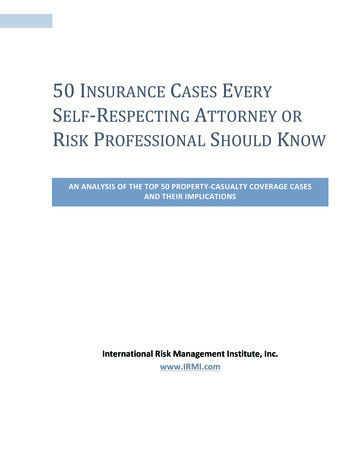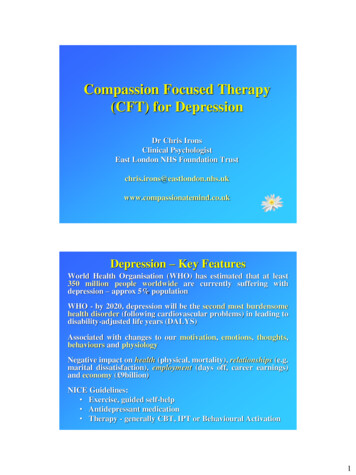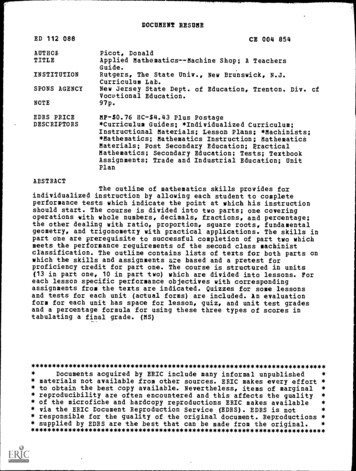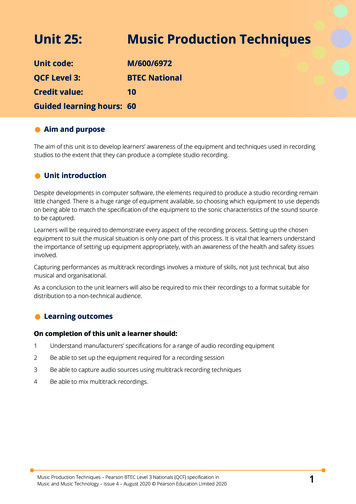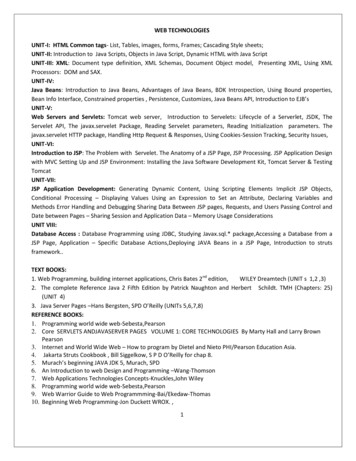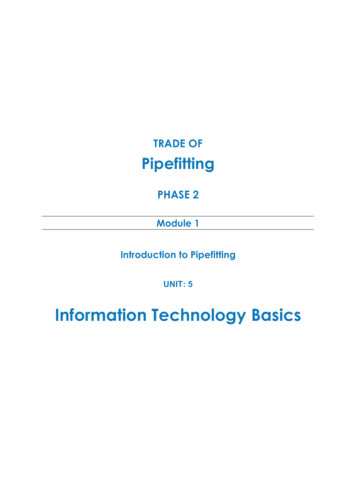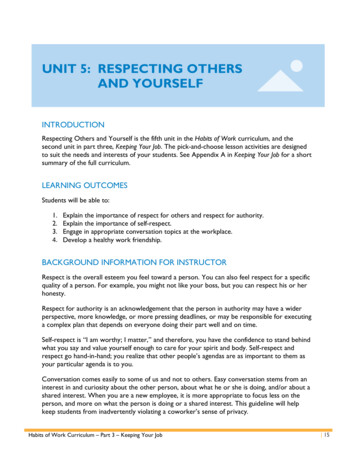
Transcription
UNIT 5: RESPECTING OTHERSAND YOURSELFINTRODUCTIONRespecting Others and Yourself is the fifth unit in the Habits of Work curriculum, and thesecond unit in part three, Keeping Your Job. The pick-and-choose lesson activities are designedto suit the needs and interests of your students. See Appendix A in Keeping Your Job for a shortsummary of the full curriculum.LEARNING OUTCOMESStudents will be able to:1.2.3.4.Explain the importance of respect for others and respect for authority.Explain the importance of self-respect.Engage in appropriate conversation topics at the workplace.Develop a healthy work friendship.BACKGROUND INFORMATION FOR INSTRUCTORRespect is the overall esteem you feel toward a person. You can also feel respect for a specificquality of a person. For example, you might not like your boss, but you can respect his or herhonesty.Respect for authority is an acknowledgement that the person in authority may have a widerperspective, more knowledge, or more pressing deadlines, or may be responsible for executinga complex plan that depends on everyone doing their part well and on time.Self-respect is “I am worthy; I matter,” and therefore, you have the confidence to stand behindwhat you say and value yourself enough to care for your spirit and body. Self-respect andrespect go hand-in-hand; you realize that other people’s agendas are as important to them asyour particular agenda is to you.Conversation comes easily to some of us and not to others. Easy conversation stems from aninterest in and curiosity about the other person, about what he or she is doing, and/or about ashared interest. When you are a new employee, it is more appropriate to focus less on theperson, and more on what the person is doing or a shared interest. This guideline will helpkeep students from inadvertently violating a coworker’s sense of privacy.Habits of Work Curriculum – Part 3 – Keeping Your Job 15
RESPECTING OTHERS AND YOURSELF (UNIT 5)Privacy varies tremendously from person to person, based on unique combinations of factorssuch as personality, culture, age, gender, workplace, and more. Comments about a person’sappearance should be avoided, as they can be considered harassment.See the readings below for some interesting thoughts on work friendships.ReadingsOn conversation: -tips-how-to-have-agood-conversation/Interesting overview on what swearing is, why people swear, how the brain processesit: people.howstuffworks.com/swearing.htmWhy work friendships matter: t-workand.htmlOther ResourcesSocial articles are like social stories, but written for older students and adults with autism.Rather than a story, the strategy is to write a news article: l-storiesBaker, J. (2006). The Social Skills Picture Book for High School and Beyond. Arlington, Texas:Future Horizons, Inc. Photographs show right (and wrong) ways to interact in differentsocial situations. Clear captions and an attractive layout are intriguing to students at alllevels of social skills. It’s a particularly good resource for the conversation lesson.Miles, B. S., Trautman, M. & Schelvan, R. (2004). The Hidden Curriculum: Practical Solutions forUnderstanding Unstated Rules in Social Situations. Shawnee Mission, KS: Autism AspergerPublishing Co. This is a good introductory resource for identifying and teasing out theinferred messages and learning for students who struggle with social skills.UNIT PREPARATION CONSIDERATIONSTasksThere are several workplace activities that involve interviewing people at the workplace.As the questions are more personal, talk with the workplace supervisor about the intent ofthe lesson and ask the supervisor to suggest good people to interview.If you want to provide more detailed starter questions and ideas for some of the journalactivities, the student materials portion of this lesson plan, “The Value of Respect,” may beuseful: s/sample lessons.html#Intermediate Respect LessonHabits of Work Curriculum – Part 3 – Keeping Your Job 16
RESPECTING OTHERS AND YOURSELF (UNIT 5)Prior KnowledgeYou may need to preteach some of these concepts depending on the lessons and activitiesyou select: chain of commandboundariesprejudice (especially race and sexual preference)body languageSUMMATIVE ASSESSMENT IDEASFollowing are ideas for a summative assessment for this unit:1. Draw two cartoon strips or create two brief scripts – one that illustrates respect/selfrespect at work and one that doesn’t. Share them with the class (learning outcomes 1, 2).2. Draw a cartoon strip that shows people having an appropriate conversation at aworkplace (learning outcomes 3, 4).3. Make a Top 10 Tips list for maintaining healthy work relationships, including yoursupervisor, coworkers, and work friends (learning outcomes 1, 2, 3, 4).4. Cut/Take Two skits. Start an improv skit about a situation where people are notdemonstrating respect. Call “Freeze” and ask for volunteers to jump in and replace thecurrent actors, taking the skit in a different direction. Call “Freeze” again and have a newcrew jump in and again switch the direction of the skit (either good or bad). Continue asdesired (learning outcomes 1, 2, 3).UNIT KICKOFFWatch this 1:40-minute video, “Ray Calls for Respect,” about disrespectful parent at asoccer game: www.youtube.com/watch?v ezZ2ZRfSsLY. Use it to start a discussion aboutwhere in their lives students have felt, given, and witnessed respect.Watch the first 2:46 minutes of this 24:09 minute video, “Sheena Iyengar on The Art ofChoosing,” during which the speaker recounts the story of trying to order green tea with sugarin Japan: www.ted.com/talks/sheena iyengar on the art of choosing.html. Use it to start adiscussion about how culture affects what is perceived as respectful. If you need to give somebackground on the importance of tea in Japan, this lesson plan will behelpful: www.pardeehome.org/TeaCulture Module.pdfHabits of Work Curriculum – Part 3 – Keeping Your Job 17
RESPECTING OTHERS AND YOURSELF (UNIT 5)LESSONSThis unit is divided into the following lessons. The lessons contain choices for activities and areorganized into an instructional sequence around a workplace Work friendshipsLessons1. RespectInstructionalSequenceIntroduction – individualActivitiesJournal. Write an entry about a personyou respect. How do you treat him or her?How does that person treat you? How do youfeel when someone treats you with respect?Journal. Look at this chart, “We Don’tFeel Respected When ”at: http://eqi.org/we dont feel respected when.htm. Think of a time you did one of thesethings to another person. If you could do itover again, how could you change yourresponse to show respect?Watch this 1:29-minute video, “WorkScenarios WithCoworkers,” www.youtube.com/watch?v 1kOn8vWA4fU, that plays a scene two ways – onethat works and one that doesn’t. Write ajournal entry about the differences you see inthe two scenarios. How does the lateemployee show respect? What happens to theirate employee when the late one showsrespect?Introduction – classroomInvite a guidance counselor to lead aworkshop on respect. Include a discussion ofwhat disrespect looks, sounds, and feels like.Watch this 8:18-minute video, “UseAnotherWord,” www.youtube.com/watch?v GMnWXz1YHo, about a successful studentcampaign to reduce hurtful language in theirhigh school. Discussion. Have you ever beenHabits of Work Curriculum – Part 3 – Keeping Your Job 18
RESPECTING OTHERS AND YOURSELF (UNIT kplace activityActivitieshurt by someone’s words, even though theydidn’t mean to hurt you? Could you dosomething similar in your class or school? Makea classroom list of words to substitute forhurtful ones.Discuss chain of command and why it’simportant in certain situations. Why do werespect authority? Are there times it’s betternot to respect authority?Disconnects. Brainstorm a list of respectful anddisrespectful phrases. Put them on cards andhave volunteers deliver the phrases to the classusing a mismatch between words and tone ofvoice and body language. Discuss the impact ofbody language on what is communicated. Howcan interpretation skew perceptions andresponses?Ask your supervisor and a coworker whatbehaviors demonstrate respect for others atyour workplace. Make a mental list of thesebehaviors.Ask your supervisor if there is a chain ofcommand at your workplace. How do peopleknow what the chain of command is? How dothey use it? Is it ever appropriate to ignore it?Follow-up – individualFollow-up – classroom2. Self-RespectIntroduction – individualHabits of Work Curriculum – Part 3 – Keeping Your JobJournal. Make yourself a respect reportcard. First generate a list of phrases thatrepresent respect. Then select the phrases thatrepresent you showing respect at work, withyour friends, grandparents, or siblings. Arethere any relationships where you would liketo show more respect?Grammy awards. List all the respectfulbehaviors identified during the workplaceactivities. Discuss them and award blue ribbonsto the three most important behaviors.Journal. Take a look at this drawing aboutself-respect f-respect.jpg. Think about the different 19
RESPECTING OTHERS AND YOURSELF (UNIT edIntroduction – classroomWorkplace activityActivitiesaspects of you: thoughts, feelings, social skills,body traits, abilities, values, actions. Then writean entry describing at least one thing yourespect about yourself in each of those aspects.Are there aspects of yourself that you valuemore than others?Journal. Survey others about what theyrespect about you. Write a journal entry aboutwhy you do or do not respect the same thingsin yourself.Word splash. Create a word splash with wordsthat represent the self-respect you have foryourself.Use the words from the word splash (seeabove) to build a class poem, starting each linewith “I respect myself for ”Character analysis. In small groups, choose apopular book, movie, or TV show and analyzethe characters for their amount of self-respect.Give the character pluses, minuses, andquestions for things you’re not sure about.Share your findings and your reasons with therest of the class. This could be aninterdisciplinary activity with an English class,where your students use a book that theEnglish class is reading.Explain to your supervisor that you arestudying respect. Ask how he or she can tellwhich employees have good self-respect (e.g.,what those people say or do that reveals it).Ask three people what they respect aboutthemselves in the workplace.Follow-up – individualJournal. Based on what you learned atyour workplace, add to your list of things yourespect about yourself. Are there qualities youcould improve to increase your self-respect?Acrostic poem. Write out your name. For eachletter of your name write a statement aboutself-respect.Journal. Based on what your supervisorHabits of Work Curriculum – Part 3 – Keeping Your Job 20
RESPECTING OTHERS AND YOURSELF (UNIT 5)LessonsSelf-respect,continued3. ConversationInstructionalSequenceActivitiestold you about how he or she knows whenemployees have good self-respect, what do youthink your workplace behaviors say about yourself-respect? On a scale from one to five, howmuch self-respect do you demonstrate atwork?Follow-up – classroomSkits. Take a typical minor work issue and act itout two ways – one with good self-respect andone with no self-respect. As a class, discusshow good self-respect makes you a betteremployee.Alphabet summary. Each student is assigned adifferent letter of the alphabet and thinks of aword or phrase starting with that letter that isrelated to self-respect. Share your ideas.Introduction – individualJournal. Notice how you speak differentlywith friends, teachers, and classmates. Write ajournal entry about what you observed and anytheories about why the differences exist.Track your swearing for a day. Note thenumber of times, where you are, who you arewith, what your mood is. Are you angry, beingfunny, anxious?Scan the news daily for a week. At the end,write down some local and national events.Write a journal entry about the events youmight mention at work and why it would showyou are curious and interested in the worldbeyond yourself.Introduction – classroomHabits of Work Curriculum – Part 3 – Keeping Your JobClassroom challenge. Can you go a day withoutswearing? Help each other meet the challenge.Each student keeps a tally chart. The next daytalk about where it was easy and where it wasdifficult not to swear. What was the feelingbehind the swearing: defense, humor, anxiety,anger? Highlight to students that it’s neverappropriate to swear during a job interview. 21
RESPECTING OTHERS AND YOURSELF (UNIT edWorkplace activityActivitiesMake a classroom list of words to substitutefor swear words in different situations.Discuss why people avoid discussing politicsand religion at work. Help students to betterunderstand personal and professionalconversations at the workplace.Conversation cards. Create cards ofappropriate and inappropriate conversations inthe workplace. Have students identity whichare which and explain their reasoning.Dyad conversations. With the whole class,review some of the suggestions at thiswebsite: www.happinessproject.com/happiness tion-with-astranger.html. Assign different techniques toeach dyad and have them practiceconversations for three to five minutes. As aclass, discuss how the conversations went.Have a 10-minute conversation about a neutraltopic: sports, hobbies, weather. Make sure thatyou allow input from the other peopleinvolved, instead of delivering a monologue ona topic of interest to you.Ask your supervisor what to do if someonebrings up an inappropriate conversation at theworkplace.Mental notes. Listen for words people useinstead of swearing.Mental notes. Observe how employees speakto coworkers. Observe how they speak tocustomers. What is their tone of voice? Dothey use different kinds of words?Follow-up – individualJournal. Make a list of conversation topicsto avoid at work. Make a second list ofconversation starters you might use instead.Make a third list of things you could say tosteer a conversation away from politics orreligion.Journal. What was it like to hold anHabits of Work Curriculum – Part 3 – Keeping Your Job 22
RESPECTING OTHERS AND YOURSELF (UNIT 5)LessonsConversation,continued4. WorkplacefriendshipsInstructionalSequenceFollow-up – classroomIntroduction – individualIntroduction – classroomWorkplace activityActivitiesintentional conversation at your workplace?Blow the horn. As a class, develop a set ofworkplace language and conversation rules.Students work in groups and create aworkplace role-play that goes in and out offollowing the rules. Students in the audience“blow the horn” when a conversation rule isbroken. Students explain why they think therule was broken and what they could dodifferently. They rewind to the place in therole-play when the rule was broken and fix it.Share observations of conversations studentsobserved at their work sites. Students areasked to present what they still question aboutworkplace conversations they observed.Facebook conversations. Speculate why peoplewill say things to each other online they wouldnot say face-to-face. What is different about anonline conversation? Also, how can people bemore conscious that employers, coworkers,and customers may see what they post?Journal. Read this short article on workfriendships: /201005/friendships-work-canwork-if. In your journal write three guidelinesfor yourself about making a friend at work.Teacher provides a walkthrough of A Day Inthe Life of Someone. The teacher walksthrough the day as this someone goes in andout of interactions with different people in hisor her life. Students note how this someoneshows friendship in different environments(home, store, workplace).Venn diagram. Create a Venn diagram tocompare and contrast work and personalfriendships (e.g., polite/informal, touch/notouch, during work hours/weekends, workparties/family parties).Ask your supervisor about companyguidelines on work friendships.Ask your supervisor about the differenceHabits of Work Curriculum – Part 3 – Keeping Your Job 23
RESPECTING OTHERS AND YOURSELF (UNIT ,continuedActivitiesbetween personal friendships and workfriendships. Does your supervisor havesuggestions for managing work friendships?Through observation and listening, studyrelationships at work. Are conversations justwork-related? Do people hang out after work?How big are people’s personal space bubbles?Follow-up – individualJournal. How might you know if you crossa line at the workplace and engage ininappropriate behavior with regard to workfriendships? How would you correct things?Journal. Create a true/false quiz for yourclass on workplace friendships.Follow-up – classroomJournal. Make a list of 10 things youlearned about work friendships.Share observations about work siterelationships. How were relationships similarand different in the different work places?Brochure. Make a brochure about healthywork friendships. Include rules for what to do,a list of inappropriate behaviors to avoid, andclues about what inappropriate may sound,feel, or look like.Have students take each other’s true/false quiz(see above) and discuss answers.Cut/take two. Make cards of corrections to geta friendship (or conversation) back on track.Start a role-play with people doing the wrongthings for workplace friendships. Cut. Do itover again experimenting with some of thecorrections.CONNECTIONS TO NH CAREER DEVELOPMENT FRAMEWORKThe NH Career Development Curriculum Framework (October 2006) establishes sevencurriculum standards “that define what New Hampshire students should know and be able todo relative to career development” at the end of grades four, eight, 10, and 12. Listed beloware the End of Grade 10 and End of Grade 12 proficiency standards addressed in this unit, someHabits of Work Curriculum – Part 3 – Keeping Your Job 24
RESPECTING OTHERS AND YOURSELF (UNIT 5)more intensely than others. Habits of Work provides practice toward these standards. Studentcompetence will depend on the activities you choose and the depth of student practice. Youmay need to develop individual activities in order for students to achieve competence.End of Grade 101.1 Access information from multiple sources and information-retrieval systems.1.3 Demonstrate the ability to summarize ideas and information.1.4 Demonstrate the ability to use a variety of organizational structures such as cause-andeffect patterns, paraphrasing, and charts and graphs to communicate ideas andinformation.1.5 Demonstrate the ability to effectively and logically support individual ideas.2.2 Identify the issues involved in making a decision or solving a problem.2.4 Use logic to draw conclusions from available information.2.5 Develop a plan that reflects research and builds on relevant precedents.2.6 Evaluate an event or activity in terms of expressed purposes.2.7 Generalize rules or principles (underlying patterns and relationships) from a set ofconclusions, objective data, written text, or system’s review, and apply those rules andprinciples to a new situation.2.8 Devise strategies for improving the performance of a system.2.9 Test the effectiveness of the strategies employed.3.1 Independently identify resources and tools needed to achieve learning goals.4.1 Demonstrate the ability to use peer and adult feedback.4.2 Demonstrate an understanding of how individual characteristics relate to achievingindividual, social, educational, and career goals.4.3 Demonstrate the importance of responsibility, dependability, punctuality, and integrity inschool, the workplace, and adult life.5.1 Demonstrate confidence and positive self-concept in beginning work-relatedexperiences, practice or actual.6.5 Identify individuals in selected occupations as possible information sources, role models,or mentors.6.6 Consult with and observe adult role models at work to identify elements of their workand determine the need for specific knowledge and skills.7.2 Demonstrate a positive attitude toward work and learning.7.4 Apply employability and job-readiness skills to internship, mentoring, shadowing, and/orother world-of-work-related experiences.End of Grade 121.1 Utilize others’ critiques as a resource in achieving goals.1.2 Demonstrate the ability to analyze how well evidence supports a conclusion or thesis.1.3 Present, explain, and defend positions, using visual aids when appropriate.1.4 Demonstrate the effective use of the conventions of the English language incommunications.1.5 Demonstrate the ability to adjust communication style and language so that it’sappropriate to the situation, topic, purpose, and audience.Habits of Work Curriculum – Part 3 – Keeping Your Job 25
RESPECTING OTHERS AND YOURSELF (UNIT 5)2.2 Analyze the design and management of a system.2.4 Develop and test strategies to optimize the performance of a system.2.5 Demonstrate how to analyze the interrelationships of events/ideas from severalperspectives.4.1 Demonstrate behaviors that maintain physical and emotional health.4.2 Demonstrate knowledge of how individuals grow and develop throughout their lives.5.1 Demonstrate consistent, responsive, and caring behavior.5.2 Demonstrate the ability to respect the rights of, and accept responsibility for, oneselfand others.5.3 Demonstrate effective and flexible team skills as a team member or leader.6.1 Use their analyses of role models to improve the planning and implementation ofprojects.Habits of Work Curriculum – Part 3 – Keeping Your Job 26
1. Explain the importance of respect for others and respect for authority. 2. Explain the importance of self-respect. 3. Engage in appropriate conversation topics at the workplace. 4. Develop a healthy work friendship. BACKGROUND INFORMATION FOR INSTRUCTOR . Respect is the overall esteem you
